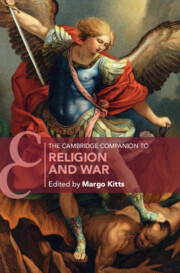Book contents
- The Cambridge Companion to Religion and War
- Cambridge Companions to Religion
- The Cambridge Companion to Religion and War
- Copyright page
- Contents
- Contributors
- Preface
- Introduction
- Part I Classical Foundations
- 1 Biblical Paradigms of War in History and Eschatology
- 2 Early Christianity and War
- 3 Fighting and Martial Valor in Islamic Thought
- 4 Hinduism and War
- 5 Buddha in the Ring of Fire
- 6 Sikhism
- 7 Religion and War in Traditional China
- 8 Buddhism and War in Premodern Japan
- Part II Just War
- Part III Religious Nationalism
- Part IV Featured Conflicts
- Index
- Cambridge Companions to Religion (continued from page ii)
- References
1 - Biblical Paradigms of War in History and Eschatology
from Part I - Classical Foundations
Published online by Cambridge University Press: 04 May 2023
- The Cambridge Companion to Religion and War
- Cambridge Companions to Religion
- The Cambridge Companion to Religion and War
- Copyright page
- Contents
- Contributors
- Preface
- Introduction
- Part I Classical Foundations
- 1 Biblical Paradigms of War in History and Eschatology
- 2 Early Christianity and War
- 3 Fighting and Martial Valor in Islamic Thought
- 4 Hinduism and War
- 5 Buddha in the Ring of Fire
- 6 Sikhism
- 7 Religion and War in Traditional China
- 8 Buddhism and War in Premodern Japan
- Part II Just War
- Part III Religious Nationalism
- Part IV Featured Conflicts
- Index
- Cambridge Companions to Religion (continued from page ii)
- References
Summary
From songs of liberation (Exodus 15) to prescriptions for genocidal violence (Deuteronomy 7:1), the biblical views on war are diverse and complicated. Ritualized preparations and borrowed Near Eastern mythological paradigms for battle have been argued to serve Israelite identity formation rather than to report actual history, but also to support fantasies of violent end-times, moments of therapeutic repose in the face of oppression, and hope for the eventual restoration of righteousness.
- Type
- Chapter
- Information
- The Cambridge Companion to Religion and War , pp. 35 - 51Publisher: Cambridge University PressPrint publication year: 2023

